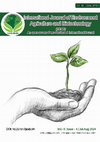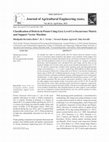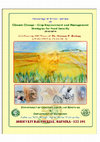Papers by Dr Ravindra B A B U Dhulipalla

D Ravindra Babu, 2024
The characteristics of crack, rotten, sprout, skin peel and good potatoes non -destructively with... more The characteristics of crack, rotten, sprout, skin peel and good potatoes non -destructively with gray level co-occurrence matrix properties (GLCMP), radon, gabor, local binary patterns (LBP) and histogram of oriented gradients (HOG) with default parameters and values i.e. adapted method were compared with improved method. Gabor feature length (16) of improved method was lower compared adapted method and improved method requires less time to plot gabor magnitude and spatial kernels for all potato classes. Radon feature row vector size is same for both adapted and improved methods for all potato classes but differ in column size. At theta value of 90 degrees (improved method), the time taken to plot radon transforms is lower compared to adapted method (using theta value 180 degree). Gray level co-occuerrence matrix properties (GLCMP) such as contrast, correlation, energy and homogeneity values were compared to both adapted and improved methods for all potato classes. Contrast values found lower in adapted method for all potato classes compared to an improved method. But remaining three properties found highest in adapted method for all potato classes compared to improved method. The default values used in adapted method of HOG feature vector length (26140) is higher compared to improved method (1330) for all types of potato images. For crack and rotten potato images, an improved method required higher time to plot visualization than adapted method, while for sprout, good and skin peel images, adapted method has more visualization time. The LBP feature length in improved method was found higher (185) compared to adapted method (59) for all potato classes. The mean time to plot squared errors in adapted and improved methods for crack images were found to be 0.6378 s and 0.6305 s respectively, for rotten images 0.2098 s and 0,2622 s, for sprout images 0.1911 s and 0.2209 s, for skin peel images 0.2197 s and 0.2197 s, for good images 0.2672 and 0.2565 s.

Dhulipalla Ravindra Babu, 2023
An attempt was made to classify potato into five classes based on features of grey level co-occur... more An attempt was made to classify potato into five classes based on features of grey level co-occurrence matrix properties and support vector machine. Potato images were captured using the developed experimental setup , which had a resolution of 0.22 mm per pixel. The four parameters of grey level co-occurrence matrix viz. variance, correlation, uniformity, and homogeneity were calculated from each image, and the data set was prepared. Sample sizes of crack, rotten, sprout, good, and skin-peel potatoes were 75, 39, 153, 96, and 635, respectively. Cracked, rotten, sprouted, good, and skin-peeled potato images were labelled as 1, 2, 3, 4, and 5, respectively. With addition of labels, the data set size increased to 998-by-five. Feature data set of 998-by-5 was fed into classification learner app in MATLAB. Combined parameters of grey level co-occurrence matrix of variance (contrast), correlation, uniformity (energy), and homogeneity were used in potato classifications. A cubic support vector machine had classification accuracy of 99.5 per cent. Quality parameters like true positive and positive predictive values were studied for cubic support vector machine model. True positive rates of 100, 97, 98, 99, and 100 were observed for crack, rotten, sprouted, good, and skin-peel categories, respectively. Crack and skin-peel categories had same number of potatoes in manual and cubic support vector machine classification. Mis-classified potatoes in cubic support vector machines were less as compared to manual classification by one, two, and two potatoes in rotten, sprouted, and good categories, respectively.
Jaggery is a sugar rich product and medicine obtained by evaporation of sugarcane (Saccharum offi... more Jaggery is a sugar rich product and medicine obtained by evaporation of sugarcane (Saccharum officinarum L.) juice or sap obtained from Palmyrah palm (Borassus flabellifer L.), Date palm (Phoenix dactylifera L.) or Coconut palm (Cocos nucifera L.). Among all Jaggery, palm Jaggery having its own importance. It usually contains 65-85% sucrose and 5-15% reducing sugars, and is consumed directly or used for preparation of sweet confectionary items and ayurvedic/traditional medicines, and it may have a role to reduce the chance of lung cancer. It is a good source of minerals like calcium, phosphorous and iron. Jaggery industry is one of the most important cottage level industries in India since ancient times and it is prepared mostly by small and marginal farmers. Besides India, countries like Pakistan, Bangladesh, Nepal, Burma and Philippines are also manufacturing Jaggery.
Development of Classification Technique for Potatoes Using Image Processing

Jaggery from Palmyrah palm ( Borassus flabellifer L.)- Present status and scope
Palm jaggery is almost like a jaggery that is made out of sugarcane juice. Palm jaggery is made f... more Palm jaggery is almost like a jaggery that is made out of sugarcane juice. Palm jaggery is made from the extract of Palm trees in Southern India. These trees are also known as Toddy palm trees or Palmyra trees. The Jaggery is processed from the unfermented Palmyra tree sap called neera. It is highly priced due to its medicinal properties 1 . It has an intense, earthy taste or reminiscent of chocolates in its taste. The palm jaggery obtained after processing is darker and richer in colour. It is slight salty to taste but much healthier of the two. Due to its cooling effects over human body, it is of high value. It does not have the bone meal content which is used for whitening processed sugar. The price of the palm jaggery is double that of sugar. Palm jaggery is quite popular in the Southern states of Tamil Nadu (called Karupatti vellam or pana vellam), Karnataka (it is called thaati bella in some places and Olebella in Mangalore, which is believed to be the best), Kerala and Andhra...
International Journal of Technical Research & Science, 2018
In this paper features like size, shape, and external defects of agricultural products were discu... more In this paper features like size, shape, and external defects of agricultural products were discussed. Major steps in image processing like enhancement, morphological operations, geometric features, pattern recognition and texture features were explained. Merits and demerits of classification techniques like support vector machine, linear discriminative analysis, fuzzy k-neural network, multilayer perceptron, mahalanobis distance classifier and learning vector quantization were furnished. The overall success of attempts on apples, potatoes was discussed. This paper is concluded with the critical remarks over the performance analysis of various techniques undertaken to carry-out the algorithm efficiencies.

National Seminar On Climate Change – Crop Improvement and Management Strategies for Food Security, 2014
Compared with other waste related sectors such as municipal composting or recycling,
vermicompost... more Compared with other waste related sectors such as municipal composting or recycling,
vermicomposting has the potential to have a high environmental impact. The organic content of
earthworm droppings encourages the passage of air and water through soil. So soil ends up being
a better environment for the critters of the soil food web and for plants. It likewise ends up being
lesslikely to compact and erode. So the resources within the soil are put to best use instead of
becoming inaccessible through compaction or erosion. Paper and paperboard products account
for 34% of the total, food scraps and yard trimmings make up 25%, and wood waste is 0.06%
(by weight). Instead of disposing of these materials in landfills, they can be recycled, composted,
or vermicomposted. In India worms studies have shown that worms remove heavy metals from
soil, which is termed as vermiremediation. The accelerated humification of organic waste with
less cost is the need of the hour and vermicomposting technology using earthworm is the
solution for the current urban organic waste. The converted urban waste through vermicompost
technology results in good humus, which is highly valued material fulfilling the major nutritional
need of plants. The use of vermicompost reduces N application rate of fertilizers, in this way the
vermicompost technology will reduce the harmful side effects to environment by the application
of huge amounts of chemical fertilizer to agricultural field thereby reducing N2O emission, a
potential Green House Gas. Organic matter in soil could effectively increase the activity of
nutrients in soil and improve their mobility and distribution in soil. Leachate from
vermicomposting operations is often regarded as beneficial in the sense that when collected it
can be used a liquid fertilizer, often called worm tea. The leachate also has the potential to
pollute when not collected and used positively. Several studies using earthworm reactors to help
treat dilute sewage found that while such reactors achieved good results, the resulting leachate
was still polluting in terms of Biological Oxygen Demand (BOD), Chemical Oxygen Demand
(COD) and nitrate concentration. Gradually, because of secondary problem of green revolution
such as soil health degradation, salinity, falling productivity, the need for development of
alternative strategies to supply the nutrient needs of crops was necessary to reduce cost of
cultivation on chemical fertilizers and their damaging effects on soil. Vermicomposting is one
such strategy followed by farmer’s to reduce the use of chemical fertilizers. As a process for
handling organic residues, it represents an alternative approach in waste management, in as much
as the material is neither land filled nor burned but is considered a resource that may be recycled.
In this sense, vermicomposting is compatible with sound environmental principles that value
conservation of resources and sustainable practices.
In this paper features like size, shape, and external defects of agricultural products were discu... more In this paper features like size, shape, and external defects of agricultural products were discussed. Major steps in image processing like enhancement, morphological operations, geometric features, pattern recognition and texture features were explained. Merits and demerits of classification techniques like support vector machine, linear discriminative analysis, fuzzy k-neural network, multilayer perceptron, mahalanobis distance classifier and learning vector quantization were furnished. The overall success of attempts on apples, potatoes was discussed. This paper is concluded with the critical remarks over the performance analysis of various techniques undertaken to carry-out the algorithm efficiencies.
Jaggery is a sugar rich product and medicine obtained by evaporation of sugarcane (Saccharum offi... more Jaggery is a sugar rich product and medicine obtained by evaporation of sugarcane (Saccharum officinarum L.) juice or sap obtained from Palmyrah palm (Borassus flabellifer L.), Date palm (Phoenix dactylifera L.) or Coconut palm (Cocos nucifera L.). Among all Jaggery, palm Jaggery having its own importance. It usually contains 65-85% sucrose and 5-15% reducing sugars, and is consumed directly or used for preparation of sweet confectionary items and ayurvedic/traditional medicines, and it may have a role to reduce the chance of lung cancer. It is a good source of minerals like calcium, phosphorous and iron. Jaggery industry is one of the most important cottage level industries in India since ancient times and it is prepared mostly by small and marginal farmers. Besides India, countries like Pakistan, Bangladesh, Nepal, Burma and Philippines are also manufacturing Jaggery.
Jaggery is a sugar rich product and medicine obtained by evaporation of sugarcane (Saccharum offi... more Jaggery is a sugar rich product and medicine obtained by evaporation of sugarcane (Saccharum officinarum L.) juice or sap obtained from Palmyrah palm (Borassus flabellifer L.), Date palm (Phoenix dactylifera L.) or Coconut palm (Cocos nucifera L.). Among all Jaggery, palm Jaggery having its own importance. It usually contains 65-85% sucrose and 5-15% reducing sugars, and is consumed directly or used for preparation of sweet confectionary items and ayurvedic/traditional medicines, and it may have a role to reduce the chance of lung cancer. It is a good source of minerals like calcium, phosphorous and iron. Jaggery industry is one of the most important cottage level industries in India since ancient times and it is prepared mostly by small and marginal farmers. Besides India, countries like Pakistan, Bangladesh, Nepal, Burma and Philippines are also manufacturing Jaggery.
According to Food and Agriculture Organization (FAO), food security exists when all people, at al... more According to Food and Agriculture Organization (FAO), food security exists when all people, at all times, have physical and economic access to sufficient, safe, and nutritious food to meet their dietary needs and food preferences for an active and healthy life. The WHO states that there are three pillars that determine food security: food availability, food access, and food use. The FAO adds a fourth pillar: the stability of the first three dimensions of food security over time. The three are interconnected. Many studies have shown that improvement in nutrition is important, even for increase in productivity of workers. Thus, food security has intrinsic (for its own sake) as well as instrumental (for increasing productivity) value.










Uploads
Papers by Dr Ravindra B A B U Dhulipalla
vermicomposting has the potential to have a high environmental impact. The organic content of
earthworm droppings encourages the passage of air and water through soil. So soil ends up being
a better environment for the critters of the soil food web and for plants. It likewise ends up being
lesslikely to compact and erode. So the resources within the soil are put to best use instead of
becoming inaccessible through compaction or erosion. Paper and paperboard products account
for 34% of the total, food scraps and yard trimmings make up 25%, and wood waste is 0.06%
(by weight). Instead of disposing of these materials in landfills, they can be recycled, composted,
or vermicomposted. In India worms studies have shown that worms remove heavy metals from
soil, which is termed as vermiremediation. The accelerated humification of organic waste with
less cost is the need of the hour and vermicomposting technology using earthworm is the
solution for the current urban organic waste. The converted urban waste through vermicompost
technology results in good humus, which is highly valued material fulfilling the major nutritional
need of plants. The use of vermicompost reduces N application rate of fertilizers, in this way the
vermicompost technology will reduce the harmful side effects to environment by the application
of huge amounts of chemical fertilizer to agricultural field thereby reducing N2O emission, a
potential Green House Gas. Organic matter in soil could effectively increase the activity of
nutrients in soil and improve their mobility and distribution in soil. Leachate from
vermicomposting operations is often regarded as beneficial in the sense that when collected it
can be used a liquid fertilizer, often called worm tea. The leachate also has the potential to
pollute when not collected and used positively. Several studies using earthworm reactors to help
treat dilute sewage found that while such reactors achieved good results, the resulting leachate
was still polluting in terms of Biological Oxygen Demand (BOD), Chemical Oxygen Demand
(COD) and nitrate concentration. Gradually, because of secondary problem of green revolution
such as soil health degradation, salinity, falling productivity, the need for development of
alternative strategies to supply the nutrient needs of crops was necessary to reduce cost of
cultivation on chemical fertilizers and their damaging effects on soil. Vermicomposting is one
such strategy followed by farmer’s to reduce the use of chemical fertilizers. As a process for
handling organic residues, it represents an alternative approach in waste management, in as much
as the material is neither land filled nor burned but is considered a resource that may be recycled.
In this sense, vermicomposting is compatible with sound environmental principles that value
conservation of resources and sustainable practices.
vermicomposting has the potential to have a high environmental impact. The organic content of
earthworm droppings encourages the passage of air and water through soil. So soil ends up being
a better environment for the critters of the soil food web and for plants. It likewise ends up being
lesslikely to compact and erode. So the resources within the soil are put to best use instead of
becoming inaccessible through compaction or erosion. Paper and paperboard products account
for 34% of the total, food scraps and yard trimmings make up 25%, and wood waste is 0.06%
(by weight). Instead of disposing of these materials in landfills, they can be recycled, composted,
or vermicomposted. In India worms studies have shown that worms remove heavy metals from
soil, which is termed as vermiremediation. The accelerated humification of organic waste with
less cost is the need of the hour and vermicomposting technology using earthworm is the
solution for the current urban organic waste. The converted urban waste through vermicompost
technology results in good humus, which is highly valued material fulfilling the major nutritional
need of plants. The use of vermicompost reduces N application rate of fertilizers, in this way the
vermicompost technology will reduce the harmful side effects to environment by the application
of huge amounts of chemical fertilizer to agricultural field thereby reducing N2O emission, a
potential Green House Gas. Organic matter in soil could effectively increase the activity of
nutrients in soil and improve their mobility and distribution in soil. Leachate from
vermicomposting operations is often regarded as beneficial in the sense that when collected it
can be used a liquid fertilizer, often called worm tea. The leachate also has the potential to
pollute when not collected and used positively. Several studies using earthworm reactors to help
treat dilute sewage found that while such reactors achieved good results, the resulting leachate
was still polluting in terms of Biological Oxygen Demand (BOD), Chemical Oxygen Demand
(COD) and nitrate concentration. Gradually, because of secondary problem of green revolution
such as soil health degradation, salinity, falling productivity, the need for development of
alternative strategies to supply the nutrient needs of crops was necessary to reduce cost of
cultivation on chemical fertilizers and their damaging effects on soil. Vermicomposting is one
such strategy followed by farmer’s to reduce the use of chemical fertilizers. As a process for
handling organic residues, it represents an alternative approach in waste management, in as much
as the material is neither land filled nor burned but is considered a resource that may be recycled.
In this sense, vermicomposting is compatible with sound environmental principles that value
conservation of resources and sustainable practices.